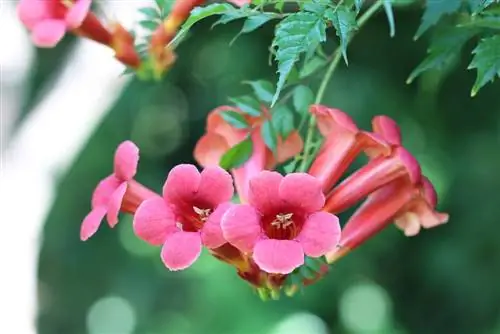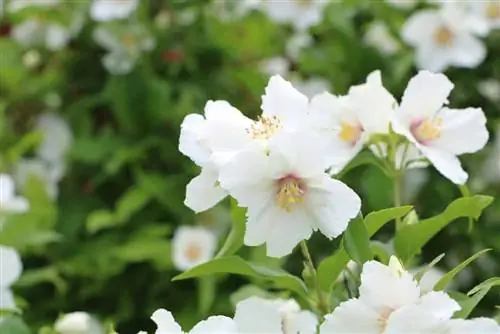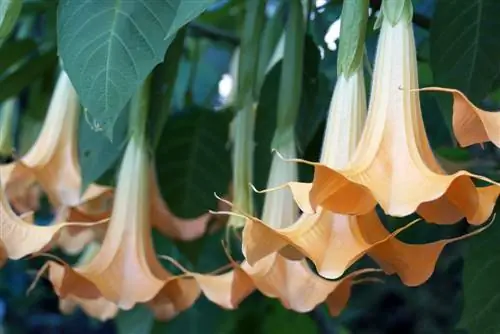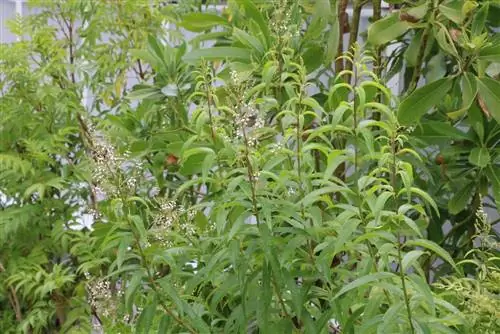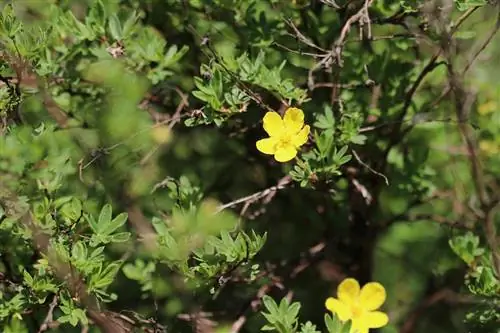- Author admin [email protected].
- Public 2023-12-17 03:39.
- Last modified 2025-01-24 12:45.
Among the ornamental trees, the trumpet bush certainly occupies a special position. The varieties that are now available to buy in our stores now combine tropical lushness with an astonishing adaptation to our climatic conditions. This magnificent piece can even survive frost without any problems if you just take a few precautions. And of course the plant is guaranteed to be a summer eye-catcher in every garden.
Location
The so-called trumpet tree family, which in principle also includes the trumpet bush, can be found everywhere in the tropics and in the dry areas of the American continent. This makes it clear that the plant likes it warm and sunny. Even though most of the trumpet bushes available on the market are special new varieties, a high need for heat and light is, to a certain extent, in their genes. Regardless of whether cultivation takes place directly outdoors or in a planter - the location should be as sunny as possible. However, partial shade is also possible. It should also be in a place relatively sheltered from the wind so as not to endanger the sensitive flowers. Also important: It must be a location where the trumpet bush can develop, after all the plant grows between three and six meters tall.
Floor
One of the many positive properties of the trumpet bush is that it is not particularly demanding. Quite the opposite: it is an extremely undemanding plant. This applies in particular to the soil or the plant substrate. In any case, specially prepared soil is not necessary. Whether the soil is neutral, acidic or alkaline does not play any role in the development of the plant. You should just make sure that the soil is loosened before planting so that water can drain away easily. Like most other plants, the trumpet bush does not like waterlogging. However, that wouldn't be too much of a problem. The plant can cope well with this even over a longer period of time without suffering major damage.
Pouring
As already indicated, all trumpet tree plants need a lot of water in order to grow and thrive. Of course this has something to do with their tropical origins. In addition, a lot of moisture evaporates through the countless leaves. In summer, daily watering is usually mandatory. The soil around the bush should generally be moist, although not necessarily wet. It can dry out for a short time now and then, but this period shouldn't last too long.
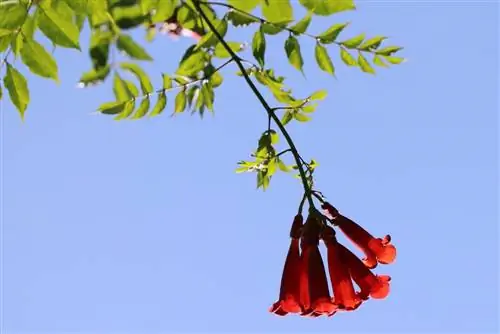
Tip:
In order to prevent the soil from drying out too quickly, ground cover plants that are planted around the trumpet bush are helpful. However, it is important to ensure that the location conditions are right for them too.
Fertilize
With the lushness with which the trumpet bush grows and the height that it can reach, one would think that it needs to be supplied with nutrients almost constantly. However, the opposite is true. The plant practically does not need fertilizing all year round. Only the addition of mulch is recommended. Otherwise, the soil should only be moderately nutrient-rich. If you still want to promote growth with fertilizer for whatever reason, you should definitely not use nitrogen-containing preparations. This would ensure that the plant grows even more, but this would also result in significantly fewer flowers.
Climbing aid
The trumpet bush is one of those ornamental plants that you basically don't have to worry about much. They cope excellently even in our climatic conditions with virtually no care. This is precisely one reason why the plant is enjoying ever-increasing popularity. However, you can make her life easier if you provide her with a so-called climbing aid. This could be a simple wooden structure or a wall without any special precautions. The wall also offers the advantage that it stores heat in summer and therefore also ensures a warm environment.
Cutting
A trumpet bush is usually very difficult to shape. It is part of its nature that it grows wild and, in our eyes, untidy. All attempts to direct it into a certain form are doomed to failure from the start. Since topiary usually takes place in summer, in this case it would also have a major disadvantage - it would only bloom to a very limited extent. A single pruning per year is completely sufficient. And that should simply promote growth.
Cutting time
The best time to cut back the trumpet bush is early spring. The cut should definitely be done at the start of budding. This may take place in February or March at the latest. Later it makes practically no sense or would even be counterproductive.
Editing technique
The trumpet bush can and must be cut back radically. All side shoots that branch off from one of the main shoots are shortened to a small cone of perhaps three to four eyes. The goal is to get as many new flower shoots as possible. You have to know that the trumpet bush usually only flowers on the annual shoots. However, because they grow on two- and three-year-old shoots, they must not be cut off completely. Rather, you should leave a cone with three to four eyes. For comparison: This corresponds to a length of approximately five to 15 centimeters. Only sharp, clean cutting tools are used for the cut. Garden scissors are ideal, but a knife may also be sufficient.
Note:
Since trumpet bushes can reach a considerable height, pruning can sometimes be a challenge. It is usually impossible to manage it without a ladder.
Propagate
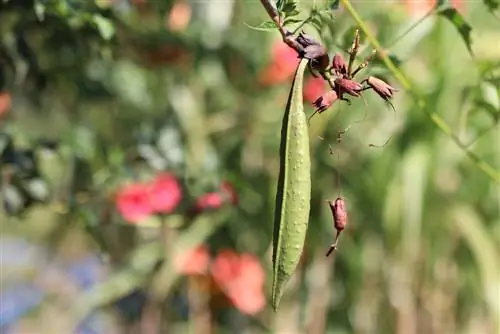
Propagating the trumpet bush is very easy. On the one hand, it can practically happen by itself if the plant loses its seeds and they fall to the ground. If you want to avoid this uncontrolled proliferation, you should definitely remove the pod-shaped fruits before they ripen. You can be more targeted with offshoots that you simply get from the cut. This is rooted in water as usual and then repotted into a first planter until they begin to produce shoots. A lot of heat, a lot of light and always moist soil are essential. Propagation is also possible using so-called root cuttings, which are cut from the mother root.
Wintering
Frost and snow are inherently unknown to the trumpet tree family. In the tropics there is neither. It is all the more astonishing that the varieties that are available from specialist retailers still cope very well with winter conditions. However, you have to differentiate between two age groups if you don't want to experience any unpleasant surprises.
Young plants
Young trumpet bushes are extremely sensitive to cold. They simply lack the substance and strength to withstand the icy temperatures. Effective winter protection is therefore required at least in the first two years after planting. In principle, the plant can remain in the ground during the winter months, but it should be very tightly covered in the area around the roots. Piles of dry leaves, for example, are suitable for this. It is also recommended to tie fir or spruce branches around the shoots to ensure reliable protection from the cold.
Old plants
From around the third year onwards, you can save yourself these measures - at least when the main shoots are already heavily woody. The plant is now strong enough to withstand temperatures as low as minus 20 degrees Celsius. It is therefore clearly considered hardy.

